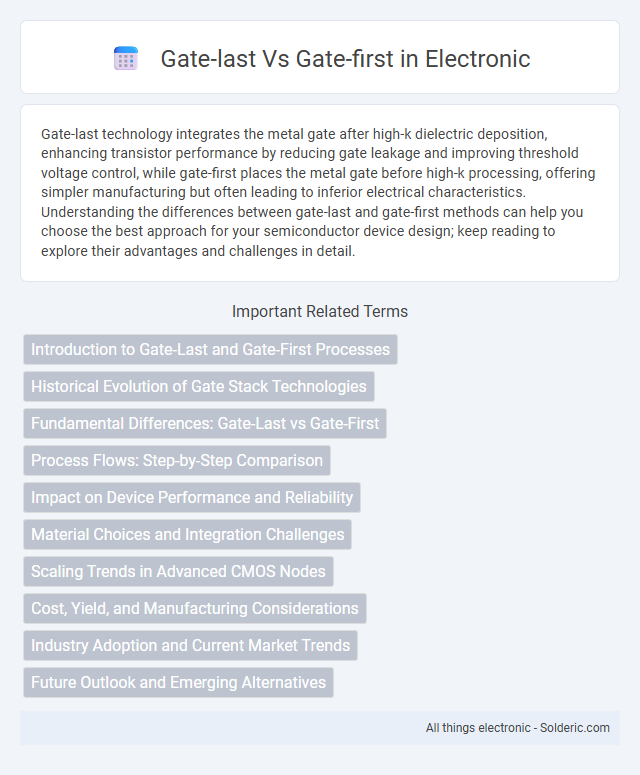Gate-last technology integrates the metal gate after high-k dielectric deposition, enhancing transistor performance by reducing gate leakage and improving threshold voltage control, while gate-first places the metal gate before high-k processing, offering simpler manufacturing but often leading to inferior electrical characteristics. Understanding the differences between gate-last and gate-first methods can help you choose the best approach for your semiconductor device design; keep reading to explore their advantages and challenges in detail.
Comparison Table
| Feature | Gate-Last | Gate-First |
|---|---|---|
| Definition | Transistors made first; gate formed last in manufacturing | Gate electrode formed before transistor source/drain regions |
| Process Complexity | Higher due to later gate fabrication | Lower, simpler fabrication steps |
| Gate Integrity | Better, as gate withstands later processing | More susceptible to damage during source/drain doping |
| Gate Dielectric Quality | Higher quality due to final gate oxidation | May degrade during early source/drain formation |
| Channel Control | Improved due to precise gate placement | Less precise, potential variability |
| Device Performance | Higher drive current, better scaling potential | Moderate performance; limited scaling |
| Applications | Advanced logic chips, high-performance ICs | Legacy technologies, simpler devices |
Introduction to Gate-Last and Gate-First Processes
Gate-last and Gate-first are two critical fabrication methods in semiconductor manufacturing, primarily used in advanced logic and memory device production. Gate-first processes involve patterning the gate electrode before high-temperature annealing, enabling better gate stack control but posing challenges for high-k/metal gate integration. Gate-last methods delay gate formation until after high-temperature steps, improving channel mobility and reducing gate leakage, making them favorable for cutting-edge CMOS technologies.
Historical Evolution of Gate Stack Technologies
The historical evolution of gate stack technologies began with gate-first processes, where the gate electrode was formed before the high-k dielectric deposition, enabling early improvements in transistor performance but facing challenges with thermal budget constraints. The transition to gate-last technology allowed the high-k/metal gate stack to be introduced after high-temperature processing, significantly enhancing mobility and reducing gate leakage in advanced nodes. Understanding these shifts helps optimize Your semiconductor fabrication strategies for improved device reliability and scaling.
Fundamental Differences: Gate-Last vs Gate-First
Gate-last and Gate-first refer to distinct fabrication sequences in semiconductor manufacturing, fundamentally differing in the order of high-k metal gate integration. Gate-first technology integrates the metal gate before high-temperature processing, enabling better gate dielectric interface quality but posing challenges during subsequent thermal steps. Conversely, gate-last processes introduce the metal gate after high-temperature annealing, improving device performance and short-channel control while complicating overall process complexity.
Process Flows: Step-by-Step Comparison
Gate-last process flow begins with transistor formation followed by high-k/metal gate deposition, improving gate oxide integrity but complicating thermal budget management. Gate-first process flows start with gate stack formation prior to source/drain implantation, enabling better control of gate dimensions and work function tuning but risk gate degradation during high-temperature anneals. Comparing step-by-step, gate-last requires substrate preparation, dummy gate patterning and removal, then high-k/metal gate filling, whereas gate-first involves early gate definition followed by source/drain activation and spacer formation.
Impact on Device Performance and Reliability
Gate-last technology offers improved device performance by reducing gate oxide defects and enhancing channel control, resulting in lower leakage currents and better drive current. Gate-first processes typically provide superior reliability due to fewer thermal budget constraints during gate formation, which helps maintain material integrity and reduce defect density. Your choice between gate-last and gate-first approaches significantly influences transistor speed, power consumption, and long-term device stability.
Material Choices and Integration Challenges
Gate-last technology typically utilizes high-k metal gate materials such as hafnium oxide combined with metal gates formed after the high-temperature annealing steps, offering better control over short channel effects and reducing gate leakage. Gate-first processes integrate metal gates early in fabrication, requiring materials like titanium nitride or tantalum-based compounds that withstand subsequent high-temperature processing without degradation, presenting integration challenges related to thermal stability. Your choice between gate-last and gate-first methods should consider these material properties and compatibility with front-end-of-line processes to optimize device performance and manufacturing yield.
Scaling Trends in Advanced CMOS Nodes
Gate-first and gate-last fabrication techniques influence scaling trends in advanced CMOS nodes by dictating the integration complexity and device performance. Gate-last processes enable improved high-k metal gate integration, reducing gate leakage and enhancing drive current, which supports scaling below 10nm. Your choice between gate-first and gate-last impacts variability control and process compatibility critical for continued transistor miniaturization.
Cost, Yield, and Manufacturing Considerations
Gate-last technology reduces production costs by simplifying the high-k metal gate integration and improving interface quality, leading to higher yield rates due to fewer defects during processing. Gate-first offers lower initial manufacturing complexity and cost but faces challenges in thermal budget management that can impact gate dielectric integrity and overall device performance. Manufacturing considerations favor gate-last for advanced nodes because of its enhanced control over work function metals and diminished process variability, resulting in better scalability and reliability.
Industry Adoption and Current Market Trends
Gate-last process technology dominates advanced semiconductor manufacturing due to its lower cost and better performance scaling, favored by industry leaders such as TSMC and Samsung for high-volume production of 7nm and below nodes. Gate-first technology sees selective adoption in specialized applications and legacy nodes where design complexity and yield control are prioritized over the aggressive scaling benefits. Market trends indicate continued investment in Gate-last for mainstream logic and memory chips, while Gate-first maintains niche relevance in power devices and mature process technologies.
Future Outlook and Emerging Alternatives
Gate-last technology offers promising scalability and cost benefits for future memory chip production, while gate-first remains prevalent for its mature integration with existing semiconductor fabrication processes. Emerging alternatives like gate-all-around (GAA) transistors and nanosheet architectures aim to surpass both by improving device performance and reducing power consumption in next-generation nodes. Your choice between gate-last and gate-first should consider the evolving industry trends and the adoption rate of these advanced transistor designs.
Gate-last vs Gate-first Infographic

 solderic.com
solderic.com